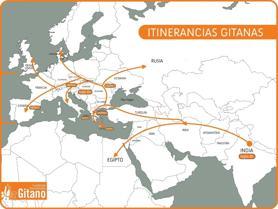Who are the European Roma?[editar]
The Roma are an ethnic group of Indian origin (Punjab region), which initiated its migratory movements towards Europe in the eleventh century AD. Its arrival in Spain, for instance, was documented from 1425. Roma groups have common linguistic and genetic origins but through history have developed significant cultural and linguistic differences. The Romani language spoken by Roma, related to the Sinhalese language still spoken in Sri Lanka, has thus diverged over time according to the geographical area or Roma community speaking it, to the point where varieties of Romani are sometimes considered languages of their own.

The Roma community is thus highly diversified, without a well-defined territory, and did not enjoy its own political and social institutions until the twentieth century. From the sixteenth century, the emergence and entrenchment of negative stereotypes (witchcraft, theft) fuelled a wave of persecution comparable only to anti-Semitism, and has since been followed by an oscillation between policies of assimilation and expulsion throughout Europe. In fact, the legal discrimination and political repression of Roma accentuated their nomadic character. The last ethnic group being legally forced into a condition of enslavement in Europe (in the Romanian region of Walachia until the 1850s), the Roma have historically experiencing widespread poverty, exclusion, discrimination and, occasionally, violence. Roma suffered internment in concentration camps and genocide under Nazi rule during the Second World War, the so-called “Porajmos” (“destruction”), during which an estimated 500,000 Roma were exterminated. The genocide of Roma was recognised officially by the German state almost four decades after the fact (in 1982), an illustration of the unequal treatment of Roma even in the official recognition of, and reparations for, such a well-documented crime against humanity.
In the Soviet bloc, assimilation policies involved restrictions to the cultural freedoms of Roma, including prohibitions of the use of the Romani language and the representation of Roma music in public events, of the nomadic lifestyle (involving forced relocations), and in some cases forced sterilisations to impede their demographic growth.
The Roma population is heterogeneous and has been undergoing profound changes in the past decades on both sides of the Iron Curtain and since the collapse of the Soviet bloc. The most noteworthy of these transformations include: the elimination of traditional labour activities and of nomadic lifestyles, urban migration, and more recently, migration from Eastern to Western Europe as a consequence of the rise of unemployment rates and worsening living standards in countries of origin, and in the context of the EU’s enlargement. The majority of European Roma today are sedentary, urban dwellers, concentrated mostly in large cities and towns – notwithstanding the persistence and, in some cases, growth of isolated rural settlements in Eastern European countries.
BACK TO MAIN ‘ROMA COMMUNITY’ PAGE’






